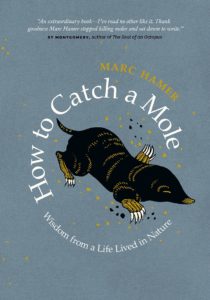The Incredibly English Art of Mole-Catching
They Might Be Cute, But They Can Also Wreak Unholy Havoc
Molecatchers produce advertising flyers and build websites. They tell you that moles on airstrips can cause serious problems for landing aircraft, that the tunnels they dig can cave in under the weight of a galloping horse and riders can be thrown. Horses in paddocks can break a leg by tripping in a collapsing mole tunnel and have to be shot. A handful of moles can cover a vast area of arable land with molehills which are quickly covered in weeds, and so crops and yields are reduced, land becomes useless for grazing and farmers suffer financial loss. Moles make more moles, which move to fields next door and spoil yet more crops and grazing.
It used to be that molehills ruined the cutters on the farm machinery used for harvesting grains. Soil from molehills mixed in with grain will spoil it and make it worthless. When this earth is accidentally harvested in animal feed used for silage it can cause listeria in cattle and their milk, and make it unfit for humans. For these reasons farmers have paid out of their profits to employ molecatchers.
For hundreds of years, it has made financial sense for them. But things change over time, and farmers are now advised to raise their cutters to avoid many of those problems. Modern machinery is designed to do this, and it works well.
Most gardeners manage a kind of frustrated acceptance of the continual bad weather that can flood a garden for weeks on end. Creatures like rats seem to be universally despised, and will be trapped, poisoned or shot; woodmice are usually enjoyed, hedgehogs are loved. Bee and wasp nests colonizing a garden shed and making it out of bounds can be frustrating, but the actions of none of these invaders seem to be taken as personally as those of a mole.
Apparently sane people lose sleep over the chaos the moles create. We do not like to lose control of our property: it makes us feel uncomfortable, impermanent, weak. Moles can ruin domestic lawns, and I have seen real hatred developing in homeowners as they lose control and ownership of their gardens. I have seen people in a temper cursing across the garden. An obsession grows and an endless, unwinnable war can take over their lives.
Moles are tiny, they are cute, and like the rest of nature they do not care what we feel. They are devastating, and they always win. Perhaps some of our anger comes because we like to think of them as being gentle and kind, with an individual personality like Mole in The Wind in the Willows, with his big glasses, his good-natured bookishness, his innocence and eagerness to please.
Moles are tiny, they are cute, and like the rest of nature they do not care what we feel. They are devastating, and they always win.Yet in reality the mole is not as introverted and self-effacing as we would like him to be. He takes advantage of us. Maybe we come to think that he is cleverer than we are. Or maybe we have a deeper relationship with and a pride in the things we own and display to others. Ownership of things that appear permanent gives us a sense of permanence. We feel ourselves immortal because of our possessions and the mole coming in and damaging them, taking them away, challenges something buried deep within us.
The effect of his burrowing far outweighs the mole’s physical size. When I show a customer a dead mole, many urban gardeners are surprised at how small they are. In the imagination the troublesome mole can grow to gigantic proportions. But usually they don’t want to see the dead enemy, just the lawn, the bright shiny lawn, just grass all neat and flat and stripy, under control, safe, for ever.
The mole disrupts the artificial serenity of a lawn in a way that is unacceptable for some. Gardening is not nature: it is using the laws of nature and science to impose our will on a place, and for some people this need for control goes to extremes. I once had a customer with a neat town garden who was obsessed with the branches on his gorgeous magnolia tree being uneven—there were more on one side than the other.
No living thing is ever perfectly symmetrical, and imperfection is where beauty is found. But this man counted the branches and cut some of them off to try to make the tree balance. He had no vision of what he wanted, he could only see what he didn’t want. I was there setting mole traps when his poor wife returned to see him covered in sawdust, holding his new electric chainsaw, and standing next to little more than a stump. The stump leaned a little to the right.
*
One of the gardens I work in has a vast flower meadow, and every year I cut this down with a scythe. I use a scythe because it is quiet and doesn’t pollute, but mainly because the wildlife has a chance to escape. Brush cutters and strimmers are devastating for wildlife: they slaughter everything in their path. Frogs, toads and hedgehogs are slashed; their flesh is blended into paste. I’ve done it, and been splashed with blood.
Deeply upset at this needless slaughter, I researched alternative ways of cutting down a meadow, and found that I could either invest thousands of pounds in another machine, or I could learn how to use and look after a scythe. I chose the scythe.
The stones in molehills in the meadow take chips out of my scythe blade, which begins every season as sharp as the razor in my bathroom cabinet, but I tolerate them. Every few strokes I stop and hone the carbon steel blade again with a smooth whetstone. At the end of the season I tap out the chipped edge using a peening hammer and anvil, to create a new edge which, like a razor blade, is a single crystal thick.
Scything is a physically hard job that requires plenty of rest breaks, especially as I get older, and so it’s a pleasure to stop and put the stone to the blade: it makes a lovely ringing sound when the stone hits the steel, and then a schwee sound as it slides along the edge from base to tip, three times usually, alternating from one side of the blade to the other.
Then the stone plops back into the water-filled tin holder hanging on my belt and I carry on scything, or just watch the birds for a moment while I get my breath back. Scything too creates a pleasing sound, a long swishh with each stroke. It has a good rhythm: swinging from the waist, cutting from the right to the left with relaxed arms outstretched, and striding slowly forward step by step, cutting a swathe up to eight feet wide, and leaving a neat windrow on my left as the stalks fall off the three-foot-long blade.
Swishh, step, swishh , step, swishh. Without my even trying, it all ends up co-ordinated with my breathing. In as I swing back and step, out as I swing for the cut. Long and slow. It used to take me two full summer days to cut down the meadow: now I’m older and it takes me more than three. Next year I may no longer be able to do it at all.
Ahead of me I can often see the small creatures running, shuffling and hopping to escape into the long grass ahead. There’s no vicious two-stroke motor screaming and making smoke, so I can hear the hedgehogs rustling and gently move them out of the way. The toads and frogs hop and crawl in front of me and I slow down, or half a dozen field mice rush along and dive into their burrows.
It is a human process, and the tools are simple and brown and honest. I have grown old with these tools: they are handmade of wood, steel and stone, and they have grown old with me and have moulded to my hand. I have a relationship with tools like this: I feel that all the things in the world that I touch are touching me back.
A reaper with a scythe traditionally leaves the last sheaf of grain standing in the middle for the spirit of the crop, “John Barleycorn,” to hide. Then it is bundled and tied and cut with a knife or sickle and taken indoors. I continue this tradition, and bring the bunch of drying wild flowers home.
The meadow is a semi-wild place by a small lake, and we are happy for the moles to live there. They are a part of the ecosystem which includes foxes, field- and woodmice, hedgehogs and millions of flying creatures, including dragonflies, lacewings, hoverflies, pheasants, owls, bats and hawks. The numbers of moles are controlled naturally by the hawks, owls and foxes. Everything here is part of the food chain.
Ahead of me I can often see the small creatures running, shuffling and hopping to escape into the long grass ahead.Scything the meadow is done twice a year. In the midspring when the grass is growing I cut the new grass back so that the slower-growing wild flowers can come through. Then in late summer, when the flowers have been and gone and shed their seed and the stalks are dry, I cut them down and leave them in windrows on the ground until the sun has dried them and the final seeds have fallen. Most native wild flowers grow best in poor soil, and if I left the stalks they would rot and increase the soil fertility, so I rake them away in warm, dry weather with a massive wooden hay rake three feet wide and carry them to the compost heap: another day’s work.
*
After the autumn equinox in September, the days become shorter and my telephone starts to ring. People have discovered molehills breaking up the perfection of their lawns and want them to be gone—they make the place untidy. The word “lawn” comes from the old Welsh word “Llan,” meaning pasture or field. The name of my own village of Llandaff in Wales means “the field by the river Taff.” This was the language of this island before the Angles, Saxons and Jutes arrived.
My first moles were caught in an immense and rolling country garden in South Wales that I look after, where I am the gardener, but later on I started catching moles in other gardens, too, as it brought me an income in the winter when otherwise I would have none.
In my early days as a gardener I was concerned that the few molecatchers I had come across showed little sensitivity, and that creatures were suffering. Looking back, of course, I have no idea what they felt. I judged them to be brutal men, but I am no different, not any more: the hammer shapes the hand, and I am molded by the life I chose.
I was aware that the moles were going to be curbed by somebody. I wondered if there were ways other than killing them. I knew that somebody would be called on to do it, and I wondered if that person could be me. So I set about researching and studying the most efficient and humane ways of dealing with moles. I like to learn new skills, especially simple ones that allow me to have a relationship with natural materials, and simple hand tools.
I read about the life cycles and habits of moles in books, on websites and in molecatchers’ advertising leaflets. I read again and again that the recommended and most humane method of controlling moles was to kill them in traps, and although I looked at all the other options it kept coming back. To get rid of them, you have to kill them.
An old farmer that I met who had been catching moles since he was a child taught me something of what he knew. Leaning on a rickety wooden four-bar fence, wearing his battered hat, he told me how to catch a live mole by creeping along in bare feet while the molehill was moving, and stopping when the mole stopped, and then at the last moment, to pounce on it with a spade and flick it into the air. I have never even tried to do this—I move too slowly. By the time I’ve got to a molehill its maker has usually finished what he was doing and moved on, and my life is too short for me to hurry.
The farmer said that moles like to build permanent tunnels along fence lines, and pointed with one of his massive hands to one such tunnel. This, he told me, had been there since he was a boy, and had been inhabited by generations of moles, one after the other, just as the traditional techniques used to catch them have been handed down through the generations of molecatchers for hundreds of years, one after the other.
Farmers are often solitary people, and tend to speak from a distance for a while. The countryside is big, and they are not used to standing close to each other, but once they have started to feel comfortable they like to talk. I usually have a good relationship with them, because I’ve learned that they have a real and visceral love for the land that they are tied to.
__________________________________

Excerpted from How to Catch a Mole, by Marc Hamer, woodcut illustrations by Joe McLaren. Published in October 2019 by Greystone Books. Excerpted with permission of the publisher.




















